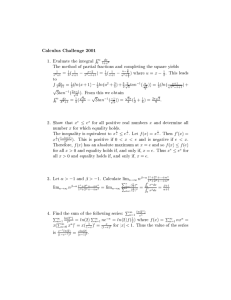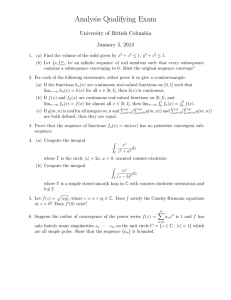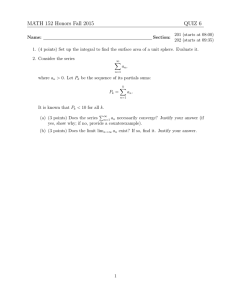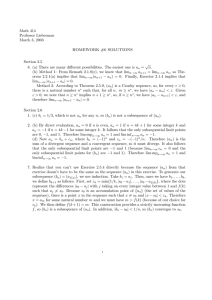Document 13289276
advertisement
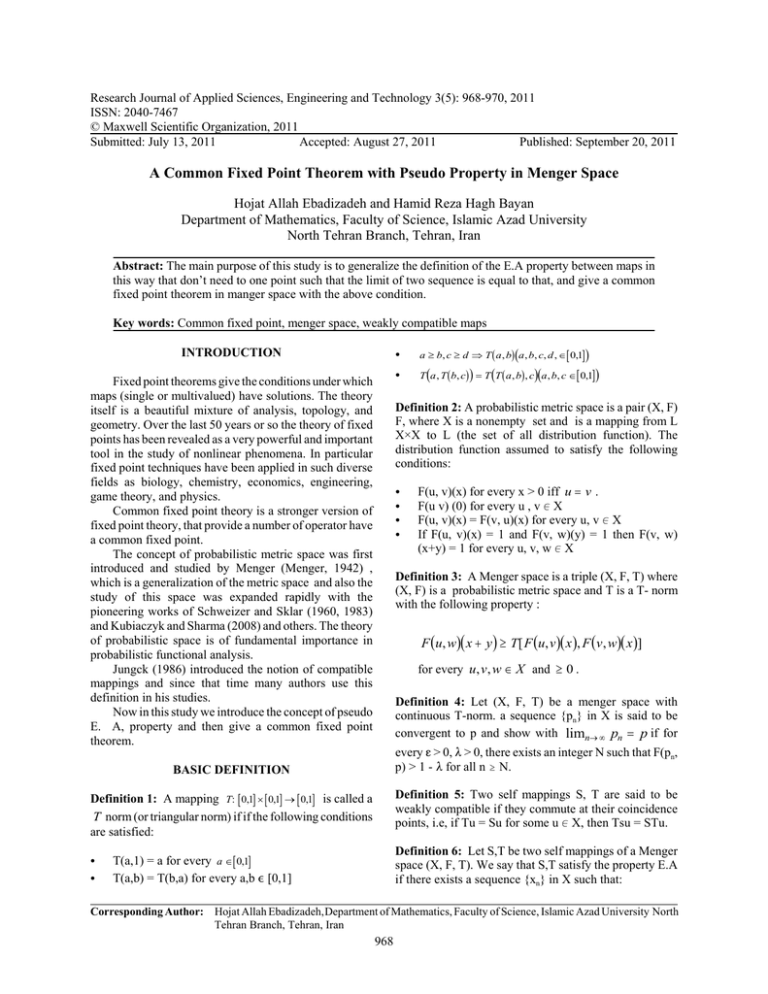
Research Journal of Applied Sciences, Engineering and Technology 3(5): 968-970, 2011
ISSN: 2040-7467
© Maxwell Scientific Organization, 2011
Submitted: July 13, 2011
Accepted: August 27, 2011
Published: September 20, 2011
A Common Fixed Point Theorem with Pseudo Property in Menger Space
Hojat Allah Ebadizadeh and Hamid Reza Hagh Bayan
Department of Mathematics, Faculty of Science, Islamic Azad University
North Tehran Branch, Tehran, Iran
Abstract: The main purpose of this study is to generalize the definition of the E.A property between maps in
this way that don’t need to one point such that the limit of two sequence is equal to that, and give a common
fixed point theorem in manger space with the above condition.
Key words: Common fixed point, menger space, weakly compatible maps
INTRODUCTION
Fixed point theorems give the conditions under which
maps (single or multivalued) have solutions. The theory
itself is a beautiful mixture of analysis, topology, and
geometry. Over the last 50 years or so the theory of fixed
points has been revealed as a very powerful and important
tool in the study of nonlinear phenomena. In particular
fixed point techniques have been applied in such diverse
fields as biology, chemistry, economics, engineering,
game theory, and physics.
Common fixed point theory is a stronger version of
fixed point theory, that provide a number of operator have
a common fixed point.
The concept of probabilistic metric space was first
introduced and studied by Menger (Menger, 1942) ,
which is a generalization of the metric space and also the
study of this space was expanded rapidly with the
pioneering works of Schweizer and Sklar (1960, 1983)
and Kubiaczyk and Sharma (2008) and others. The theory
of probabilistic space is of fundamental importance in
probabilistic functional analysis.
Jungck (1986) introduced the notion of compatible
mappings and since that time many authors use this
definition in his studies.
Now in this study we introduce the concept of pseudo
E. A, property and then give a common fixed point
theorem.
a ≥ b, c ≥ d ⇒ T ( a , b)(a , b, c, d , ∈[ 0,1])
C
T (a , T ( b, c) ) = T (T ( a , b) , c)(a , b, c ∈[ 0,1])
Definition 2: A probabilistic metric space is a pair (X, F)
F, where X is a nonempty set and is a mapping from L
X×X to L (the set of all distribution function). The
distribution function assumed to satisfy the following
conditions:
C
C
C
C
F(u, v)(x) for every x > 0 iff u = v .
F(u v) (0) for every u , v 0 X
F(u, v)(x) = F(v, u)(x) for every u, v 0 X
If F(u, v)(x) = 1 and F(v, w)(y) = 1 then F(v, w)
(x+y) = 1 for every u, v, w 0 X
Definition 3: A Menger space is a triple (X, F, T) where
(X, F) is a probabilistic metric space and T is a T- norm
with the following property :
F (u, w)( x + y ) ≥ T[ F (u, v )( x ), F (v , w)( x )]
for every u, v , w ∈ X and ≥ 0 .
Definition 4: Let (X, F, T) be a menger space with
continuous T-norm. a sequence {pn} in X is said to be
convergent to p and show with limn→ ∞ pn = p if for
every g > 0, 8 > 0, there exists an integer N such that F(pn,
p) > 1 - 8 for all n $ N.
BASIC DEFINITION
Definition 1: A mapping T: [ 0,1] × [ 0,1] → [ 0,1] is called a
T norm (or triangular norm) if if the following conditions
are satisfied:
C
C
C
Definition 5: Two self mappings S, T are said to be
weakly compatible if they commute at their coincidence
points, i.e, if Tu = Su for some u 0 X, then Tsu = STu.
Definition 6: Let S,T be two self mappings of a Menger
space (X, F, T). We say that S,T satisfy the property E.A
if there exists a sequence {xn} in X such that:
T(a,1) = a for every a ∈[ 0,1]
T(a,b) = T(b,a) for every a,b , [0,1]
Corresponding Author: Hojat Allah Ebadizadeh, Department of Mathematics, Faculty of Science, Islamic Azad University North
Tehran Branch, Tehran, Iran
968
Res. J. Appl. Sci. Eng. Technol., 3(9): 968-970, 2011
C
limn → ∞ Sxn = limn→ ∞ Txn = z
for some z , X.
limn→ ∞ Sxn = limn→ ∞ Txn
Definition 7: Let S , T be two self mappings of a Menger
space (X, F, T). We say that S, T are pseudo E. A if there
exists a sequence {xn} in X such that:
limn→ ∞ Sxn = limn→ ∞ Txn
C
C
Example 1: Let X = [0, 4) and define S , A: X → X by:
Tx =
x
4
, Sx =
C
C
3x
(x ∈ X)
4
C
Consider the sequence {xn = 1/n}. Clearly lim n→ ∞ Tx n = 0 .
So S and T satisfy the E. A property and pseudo E. A
property.
Example 2: Let X = [0, ∞ ) and define S , T: X → X by:
F ( Txn , Ta )( kx ) ≥
min {F(Sxn, Sa)(x), F(Sxn, Txn)(x), F(Sa, Ta)(x),
F(Sa, Txn)(x), F(Sxn, Ta)(x)}
Letting n → ∞ , yields,
F(Sc, Ta)(kx) $ F(Sa, Ta)(x)
Which is a contradiction by definition 3. Therefore
Sa = Ta.
Since T and S are weakly compatible, Sa = Ta and
therefore, Tta = Tsa = Sta = SSa(*)
F ( Ta , TTa )( kn) ≥ min{F ( Sa , STa )( x )
Consider the sequence {xn = n}. Clearly
F ( Sa , Txn)( xn) , F ( Sa , Ta )( x ) ,
lim n→ ∞ Sx n = lim n → ∞Tx n = ∞ .
F ( STa , Ta )( x ) , F ( Sa , TTa )( x )}
Therefore, S and T satisfy the pseudo E. A property.
Note that if we regard X f [0, 4], then 4 óX. So the
class of operator that satisfy the pseudo E. A property is
bigger that the class of operator that satisfy the E. A
property.
By (*), from the above inequalities we have,
F(Ta, Tta)(kx) $ F(Ta, TTa)
This is a contradiction. Therefore Ta = TTa. Thus STa =
TTa = Ta.
When TX is assumed to be closed subset of X, the
proof is similar, since TX f SX. If Sz = Tz = z, and Ta …
z, we have,
RESULTS AND DISCUSSION
Now in this section we give theorems between
mappings that have pseudo E. A property.
F ( Ta , Tz )( kx ) ≥ min{F ( Sa , Sz )( x )
Theorem 1: Let (X, F, T) be a menger space with T(x, y_
= min(x, y) for all x, y 0 [0, 1]. Let S and T be weakly
compatible mappings X of into itself such that,
F ( Sa , Ta )( x ) , F ( Sz , Tz )( x ) , F ( Sz, Ta )( x ) , F ( Sa , Tz )( x )}
= F ( Ta , Tz )( x )
S and T satisfy the pseudo E. A property
There exists a number k 0 (0, 1) such that,
which is a contradiction. So the common fixed point Ta
is unique.
F ( Tu, Tv )( kx ) ≥ min{F ( Su, Sv )( x ) , F ( Su, Tu)( x ) ,
F ( Sv , Tv )( x ) , F ( Sv , Tu)( x ) , F ( Su, Tv )( x )}
C
C
Suppose that
is closed. Then we
SX
have limn → ∞ Sxn = SA for some a 0 X. Also
limn → ∞ Txn = Sa . We show that Ta = Sa.
Suppose that Ta ≠ Sa .
By condition ii) we have,
Finally we show that Ta is a common fixed point of S and
T.
Suppose that Ta … TTa, then by condition ii) we have,
Tx = x , Sx = x + 1( x ∈ X )
C
C
Proof: Since S and T satisfy the pseudo E. A
property, there exists a sequence {Xn} in X such that:
CONCLUSION
for all u, v 0 X
TX f SX
If TX or SX be a closed subset of X, then S and T
have a unique common fixed point.
In this study we define the concept of Pseudo E.A.
property and then a common fixed point theorem with its
proof stated. Note that this definition make us more
flexible in dealing with real-world problems.
969
Res. J. Appl. Sci. Eng. Technol., 3(9): 968-970, 2011
Kubiaczyk, I. and S. Sharma, 2008. some common fixed
point theorems in Menger space under strict
contractive conditions. Sou. Asi. Bull. Math. 32:
117-124.
Menger, K., 1942. Statistical metric, Proc. Natl. Acad.
Sci. USA, 28(12): 535-537.
Schweizer, B. and A. Sklar, 1960. Statistical spaces.
Pacific. J. Math., 10: 313-334.
Schweizer, B. and A. Sklar, 1983. Probabilistic Metric
Space. Vol. 5, North- Holland, Series in Probability
and Applied Math, NY, USA.
ACKNOWLEDGMENT
The authors are grateful than referee(s) for valuable
comment for improving this work and Islamic Azad
University, North Tehran branch, Tehran, Iran for
supporting this work and Dr. M. Foozooni for his deep
insight of fix point that help us.
REFERENCES
Jungck, G., 1986. Compatible mappings and common
fixed points. Internat. J. Math. Sci., 9(4): 771-779.
970
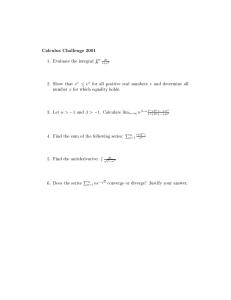
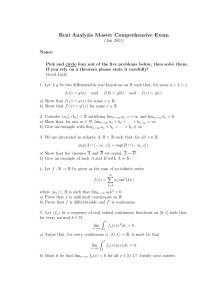
![Student number Name [SURNAME(S), Givenname(s)] MATH 101, Section 212 (CSP)](http://s2.studylib.net/store/data/011174933_1-081ebf80bf43ac08138d79d2c48b6c32-300x300.png)
